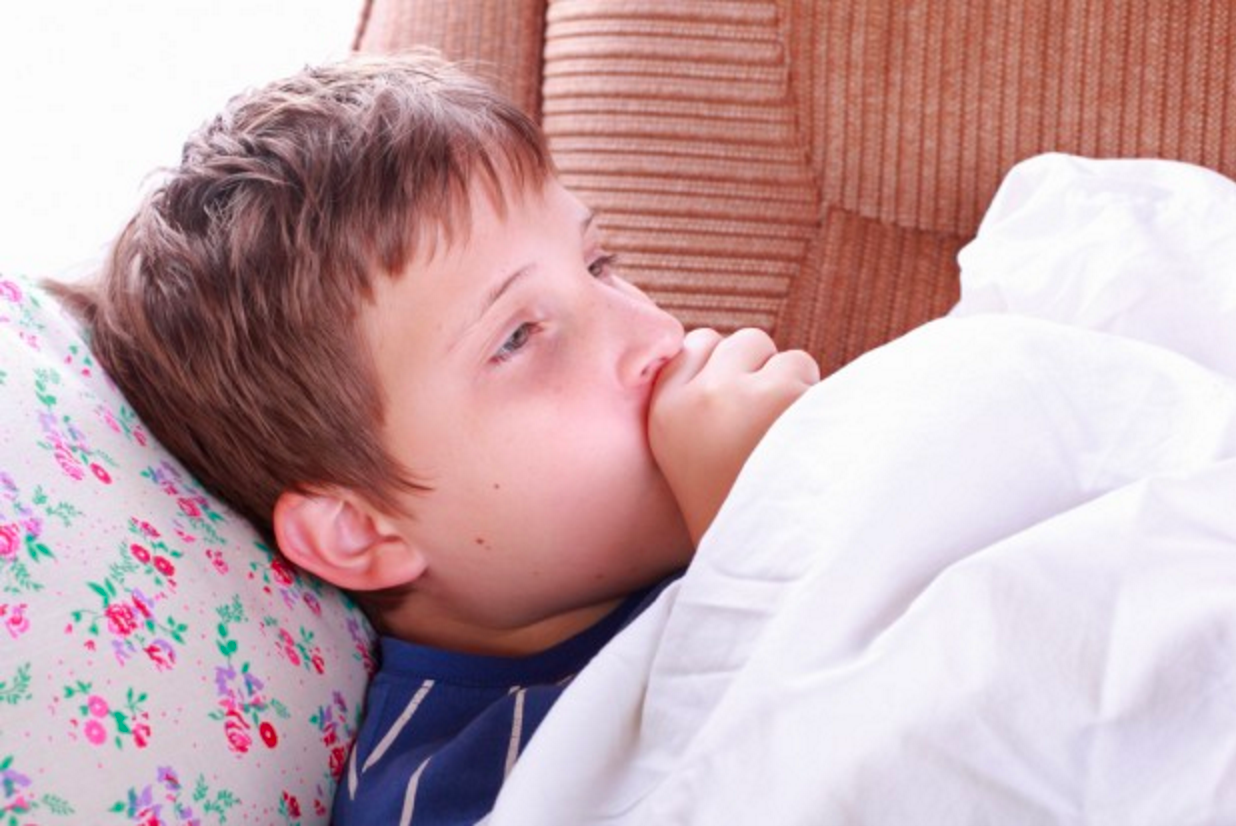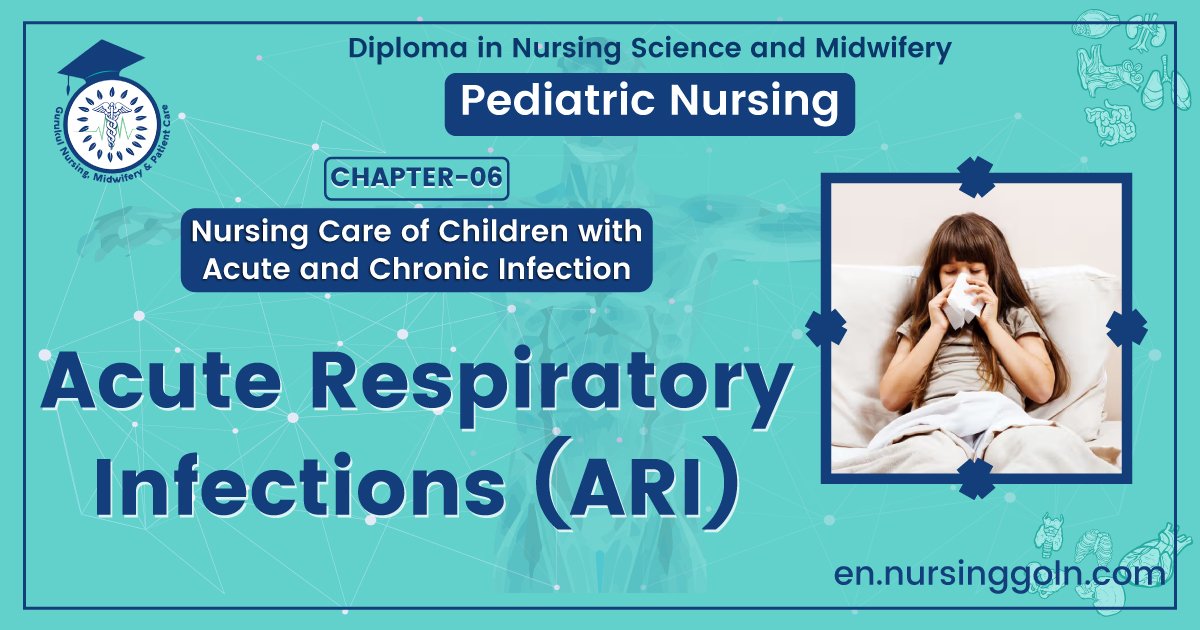Acute respiratory infections (ARI) – Health of the children has been considered as the vital importance to all societies because children are the basic resource for the future of humankind. Nursing care of children is concerned for both the health of the children and for the illnesses that affect their growth and development. The increasing complexity of medical and nursing science has created a need for special area of child care, i.e. pediatric nursing.
Pediatric nursing is the specialized area of nursing practice concerning the care of children during wellness and illness. It includes preventive, promotive, curative and rehabilitative care of children. It emphasizes on all round development of body, mind and spirit of the growing individual. Thus, pediatric nursing involves in giving assistance, care and support to the growing and developing children to achieve their individual potential for functioning with fullest capacity.
Acute respiratory infections (ARI)

Acute respiratory infections (ARI) and its complications are most frequent conditions of acute illness in infants and children. In Bangladesh, ARI is one of the major causes of childhood death. It is also one of the major reasons for which children are brought to the hospitals and health facilities.
About 13% of inpatient death in pediatric wards is due to ARI. The proportion of death due to ARI in the community is much higher as many children die at home. Most children have 3 to 5 attacks of ARI in each year. Many of these infections run their natural course without specific treatment and without complications.
Definition of ARI:
ARI is an episode of acute symptoms and signs resulting from infection of any part of respiratory tract or any related structures including Para-nasal sinuses, middle ear and pleural cavity.
[Ref-Rashid, Khabir, Hyder/5th/364]
Or
Acute respiratory infections are an acute infection of any part of the respiratory tract and related structures including paranasal sinuses, middle ear and pleural cavity. It may cause inflammation of respiratory tract anywhere from nose to alveoli with a wide range of combinations of symptoms and signs.
(Ref by: Parul Datta /Pediatric Nursing 4h/243)
Classification of ARI:
Acute upper respiratory infections (AURI):
➤Common cold
➤Otitis Media
➤ Pharyngitis
Acute lower respiratory tract infections (ALRD:
➤ Epiglottitis
➤ Laryngitis
➤ Laryngo-tracheitis
➤ Bronchitis
➤ Broncheolitis
➤ Pneumonia
Classification of ARI According to Severity of Illness:
Child aged 2 months upto 5 years:
➤ Very severe disease.
➤Severe pneumonia.
➤ Pneumonia (not severe).
➤No pneumonia: Cough or cold.
Infants less than 2 months of age:
➤ Very severe disease.
➤ Severe pneumonia.
➤ No pneumonia: Cough or cold.

[Ref by-Park/24/179-181)
Clinical Features of ARI:
➤Running nose.
➤ Cough.
➤Sore throat.
➤ Difficult breathing.
➤ Ear problem (e.g. pain).
➤ Fever.
Another Answer
The clinical features of ARI depend upon age of the children, site and severity of infections, causative organism, general health and associated medical conditions.
Common manifestations of ARI are –
- Nasal discharge (watery or mucoid),
- Cough,
- Fever,
- Malaise,
- Anorexia,
- Sore throat,
- Irritability,
- Chest pain,
- Chills,
- Tachycardia,
- Respiratory distress,
- Ear problems, etc.
Upper respiratory infections may present as dry cough with postnasal discharge, purulent nasal discharge and inflammation of tonsils, pharynx and glands.
Causes/ Agents of ARI:
Bacteria:
- Bordetella pertussis
- Corynebacterium diphtheriae
- Haemophilus influenzae
- Klebsiella pneumonia
- Legionella pneumophilia
- Staphylococcus aureus
- Streptococcus pneumoniae
- Streptococcus pyogenes
Virus:
- Adenoviruses
- Enteroviruses
- Influenza
- Measles
- Para-influenza
- Respiratory syncytial virus
- Rhinoviruses
- Coronavirus
Other agents:
- Chlamydia type
- Coxiella burnetti
- Mycoplasma pneumoniae

[Ref by-Park/24/179-181]
Another Answer
Causes of ARI:
The causative organisms of the infections include the followings:
➤ Bacterial: Pneumococcus, Staphylococcus, Streptococcus, H. influenzae, Klebsiella, M. tuberculosis, E. coli, H. pertussis.
➤ Viral: Influenza, measles, chickenpox, respiratory syncytial virus (RSV).
➤Mycoplasma: Mycoplasma pneumoniae.
➤ Fungal: Candidiasis, coccidioidomycosis, histoplasmosis, blastomycosis. Protozoal: Pneumocystis carinii, Toxoplasma gondii, E. hystolytica.
➤ Rickettsial: Typhus
➤ Miscellaneous: Aspiration pneumonia (amniotic fluid in newborn, vomitus, drowning, foreign body), chemical pneumonia (due to kerosene oil poisoning), hypostatic pneumonia, Loeffler pneumonia, etc.
(Ref by: Parul Datta /Pediatric Nursing 4th/243)
Management
Treatment depends upon type of illness, severity of infections and associated complications, the standard treatment for childhood ARI is recommended by National ARI Control Program especially for primary health care setting.
- The child with ‘no pneumonia’ can be treated at home with home remedies for symptomatic treatment (fever and cough) and does not require antibiotic therapy. The child with ‘pneumonia’ can be treated in outpatient department (OPD) with oral antibiotics and other symptomatic treatment like antipyretic and bronchodilator.
- The child with ‘severe pneumonia” should be hospitalized urgently and requires parenteral antibiotics with symptomatic treatment.
- The child with ‘very severe disease’ needs immediate hospitalization and to be treated with parenteral antibiotics, oxygen therapy, antipyretics, bronchodilators and other supportive care.
The effective antibiotic therapy
- Cotrimoxazole, penicillin, ampicillin, cloxacillin, gentamicin, amoxicillin, chloramphenicol, erythromycin or cephalosporin (cefotaxime or ceftriaxone).
- Bronchodilators like deriphyllin or salbutamol may be needed.
Supportive general measures
- Bed rest,
- Propped up position,
- Warmth,
- Isolation,
- Suctioning to remove secretions from tracheobronchial tree,
- Adequate fluid and dietary intake, humid environment,
- Hygienic measures,
- Clearing of air passage and nose, monitoring of child’s condition (vital signs, 02 saturation, pulse oximetry),
- Postural drainage,
- Chest physiotherapy and treatment of complications.
In complicated cases, surgical interventions may be needed, e.g. aspiration in case of empyema, closed chest drainage in case of pyopneumothorax and ventilatory support in case of respiratory failure.
(Ref by: Parul Datta /Pediatric Nursing 4h/243-244)
Nursing Management
Nursing Assessment
- To determine the severity of infection and respiratory problems, initial assessment to be made and thereafter continuous monitoring of the child’s condition is essential throughout the course of illness.
- Initial history of present complaints and history of illness help to assess the need for priority interventions. Details history of different aspects should be collected when the child’s condition becomes stable. Duration of illness, age of the child, previous illness, presence of associated symptoms, and any treatment taken before, are very important along with routine history.
- Physical examination need to be done including percussion and auscultation to diagnose the extent and severity of infections. Respiratory pattern, associated signs and symptoms, features of complications to be evaluated carefully. Thorough general and systemic examination must be performed.
Nursing Diagnosis
- Nursing assessment helps to document nursing diagnosis. It should be recorded clearly, because it is very essential for further nursing management. The common nursing diagnoses for the child with ARI can be:Ineffective airway clearance related to inflammation, obstruction or secretions of respiratory tract.
- Ineffective breathing pattern related to inflammatory process.
- Fluid volume deficit related to fever, anorexia and vomiting.
- Fatigue related to increased work of breathing.
- Anxiety related to respiratory distress and hospitalization.
- Parental role conflict related to illness of the child.
Nursing Interventions
In general, nursing interventions for a child with ARI include the followings:
- Provision of bed rest with comfortable position and head up.
- Administration of oxygen therapy and clearing of air passage by removing secretions.
- Maintenance of warm, humid and well-ventilated environment.
- Maintenance of adequate hydration by oral or parenteral fluid and recording of intake and output.
- Provision of adequate nutrition by breastfeeding or dietary intake. Nasogastric tube feeding may be necessary. If the child is having airway obstruction, breast sucking is usually withheld to prevent aspiration and suffocation.
- Practicing safe measures for prevention of accidents and other infections.
- Monitoring of child’s condition continuously with immediate recording.
- Provision of frequent change of position (2 hourly). Chest physiotherapy and postural drainage may be useful to prevent complications and for early recovery.
- Administration of prescribed medications and recording of treatment given (antibiotic, antipyretic, bronchodilator, etc.)
- Giving tepid sponge to treat fever.
- Maintenance of personal hygiene and elimination.
- Explanation and reassurance to the parent and child about treatment plan and prognosis. Involving parent in child care should be as much as possible.
- Arrangement of play materials, in recovery phase for diversion and recreation and to reduce anxiety and tension related to hospitalization.
- Planning for discharge from hospital and home care. Health education to the parent and family members must be given for home care, follow-up and prevention of further attack.
(Ref by: Parul Datta /Pediatric Nursing 4/244)
Preventive/Control measures of ARI:
- Improved living conditions.
- Better nutritional care.
- Reduction of smoke pollution, indoors & other domestic air pollution.
- Provision of better MCH care.
- Breast feeding.
- Hydration maintenance.
- Immunization of the children.
- Families are taught to avoid crowding in living & sleeping quarters.
- Ensure proper ventilation.
- Maintenance of personal hygiene.
- Sanitary disposal of discharges from mouth & nose.
- Families with young children must be helped to recognize pneumonia.
- Concurrent disinfection of eating & drinking utensils.
- Health promotional actives or health education.
- Community support.
(Ref by-Park/24/178+ Rashid, Khabir, Hyder/5/366)
Another Answer
Preventive Measures of Acute Respiratory Infections
Acute respiratory infections (ARI) can be prevented by modification of risk factors related to respiratory infections and other diseases. Family members and parents need to be informed about the followings:
- Good hygienic practices related to personal and environmental hygiene.
- Appropriate handling and disposal of respiratory secretions of the infected individuals.
- Isolation of the infected patients and to take precautions to prevent spread of infections.
- Maintenance of warm well-ventilated environment.
- Avoiding synthetic clothing and exposure of skin.
- Special protection during weather variation to prevent cold.
- Maintenance of nutritional status with exclusive breastfeeding up to 4-6 months, weaning from 4 to 6 months and balanced diet thereafter. Adequate hydration should be maintained.
- Immunization to be completed as per schedule.
- Use of home remedies for cough and cold, e.g. tulsi, honey, basak, zinger, hot drinks, etc.
- Regular health check-up for detection of deviation from normal health and growth and development, nutritional status and associated problems.
- Avoiding harmful practices related to child care during illness or in wellness.

(Ref by: Parul Datta /Pediatric Nursing 4h/245)
Complications
Complications of ARI include
- Pleural effusion,
- Emphysema,
- Atelectasis,
- Empyema,
- Lung abscess,
- Bronchiectasis,
- Pyopneumothorax and pneumatocele.
Otitis media, chronic sinusitis, pericarditis, congestive cardiac failure, respiratory failure and paralytic ileus may also develop. Metastatic spread may cause meningitis, septic arthritis and osteomyelitis.
(Ref by: Parul Datta/Pediatric Nursing 4h/243)
Read more:
